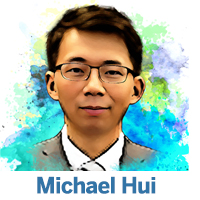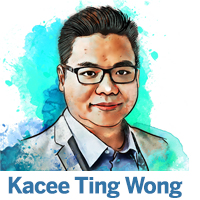Economist Stephen Roach recently reaffirmed his pessimism about the economy of the Hong Kong Special Administrative Region, emphasizing an economic slowdown in China and the heightened geopolitical rivalry between China and the United States. At the heart of his analysis is, and always has been, the adverse effects on the SAR’s economy of the increased pace of “mainlandization”. Our economy would struggle to spring back to life on its own without a rebound in the Chinese mainland economy, according to the former Hong Kong-based chair of Morgan Stanley Asia.

 Doom-mongers often like to make baseless accusations about the erosion of the city’s political autonomy. They also elaborate at length on the negative effects of the closer economic ties between the SAR and the mainland, in particular other cities in the Guangdong-Hong Kong-Macao Greater Bay Area.
Doom-mongers often like to make baseless accusations about the erosion of the city’s political autonomy. They also elaborate at length on the negative effects of the closer economic ties between the SAR and the mainland, in particular other cities in the Guangdong-Hong Kong-Macao Greater Bay Area.
Weighing the pros and cons of the deeper economic integration between the city and the mainland, we would like to emphasize that Hong Kong is uniquely positioned under the “one country, two systems” principle to capture the promise of China’s pivot toward technological and innovative frontiers. Furthermore, deeper integration will bring more opportunities for foreign investors, and Hong Kong’s professional and service sectors. Forcing these doom-mongers to see what is in front of their noses, we must point out that many of them have underestimated the resilience of the Chinese economy and the strong determination of the Chinese people to promote economic development in the country.
Though the “3D problems” of debt, deflation and demography mentioned by Roach have provided significant headwinds to the economy of China, we want to provide our readers with a balanced analysis. China’s remarkable achievements in green transition and the emergence of corresponding industries have given the Chinese economy a new lease on life. Commentators regard new energy, green transport, new materials and high-tech manufacturing industries as important components of new quality productive forces. They will revolutionize China’s competitive game in the long run. In order to navigate a turbulent world of intense geopolitical rivalry, China has already been shifting most exports to the Global South and relocating production to developing economies. For example, Mexico has become China’s second-largest importer of cars.
To begin with, we look at the determination of Beijing to reform and strengthen its economy. In early 2021, President Xi Jinping emphasized the need to improve and upgrade the industrial structure, increase China’s capacity for innovation, enhance its competitiveness, boost the resilience of the supply system and produce higher-quality output with greater efficiency, so as to achieve a dynamic economic equilibrium at a high level. His emphasis on new quality productive forces offers grounds for cautious optimism that the second-largest economy will be able to promote high-quality economic development in a sustainable manner.
We hope our analysis of solar panels, electric vehicles (EVs), lithium-ion batteries and hydrogen vehicles can create a new space for discourse on China’s lesser-known efforts to promote green transition and high-quality economic development.
First, China enjoys great competitive advantages in producing solar panels. The top seven global solar panel manufacturers are mostly Chinese.
Second, China has an entire supply chain to produce EVs. The supply chain includes the globally mined metals that are used to make batteries, complicated spare parts and complex software installed in EVs. China has people that can run every level of the supply chain.
Third, Wan Gang, a former minister of science and technology of China, deserves applause for his great contribution to promoting the development of EVs in China. He convinced Chinese leaders two decades ago to bet on EVs, seeing them not only as a way to boost economic growth but also to tackle China’s dependence on oil imports and pollution. But the bet on EVs would not have been successful without the astonishing development of lithium-ion batteries in China. According to BloombergNEF estimates, by 2025 China’s lithium-ion battery production will be three times as big as the rest of the world combined. With an exceptionally strong client base, Contemporary Amperex Technology Ltd of Fujian province is the world’s largest battery company.
Fourth, Wan predicts that China’s hydrogen vehicles will play an important role in the world’s auto market. Promoting hydrogen is very beneficial as the fuel can also be used in maritime and rail transport. As a manifestation of the competitive edge enjoyed by Chinese manufactures, Fujian-based Wisdom Motor deserves credit for winning a contract to supply hydrogen buses to Abu Dhabi. It is also worth noting that China has taken the lead on electrolyzer development. As a hydrogen production pathway, electrolysis helps separate the hydrogen and oxygen in water molecules. The reaction takes place in a unit called an electrolyzer.
Kelvin Wong, a financial analyst at Oanda, has noted green shoots in China’s purchasing managers’ activity. According to Wong, the latest set of positive macro data suggests the piecemeal stimulus measures from China’s top policymakers are working to negate the deflationary risk spiral that has been triggered by the significant slowdown inherent in the domestic property market. It is likely that policies to deepen reforms and advance China’s modernization will be announced during the third plenary session of the 20th Communist Party of China Central Committee. Policies due to be discussed at the upcoming plenum will likely be far-reaching.
Because of space constraints, we are unable to respond to Roach’s “Hong Kong is over” theory in detail. We will instead focus on the benefits brought about by deeper economic integration of the SAR into the GBA. Mainland GBA cities can help Hong Kong build innovation and technology hubs in the Northern Metropolis by sending us their tech talents, engineers and tech enterprises that want to use the SAR as a launch pad for their international operations (Regina Ip, HK Pearl of Greater Bay Area, China Daily, June 3, 2024). Because of the historically close ties between Hong Kong and Foshan, SAR entrepreneurs may find it easier to collaborate with high-tech enterprises in Foshan. Sino-German Industrial Service Zone in Foshan, Guangdong province, for instance, is a high-end international cooperation zone for all Guangdong industries. Deeper integration will also promote the service trade between Hong Kong and other cities of the GBA.
Contrary to Roach, fund manager Mark Mobius declared that the city is far from over. He said he found Hong Kong largely unchanged during his recent visit to the city, where he saw the same hustle, ambition and determination to succeed that impressed him back in the 1960s. Shan Weijian, chairman and CEO of investment firm PAG, was also optimistic about the city’s economic outlook. In spite of our overall objection to Roach’s “Hong Kong is over” theory, we must state that we are grateful to him for criticizing the imposition of protectionist tariffs by the US on Chinese EVs, lithium-ion batteries and other products.
Michael Hui is director of international trade affairs at Chinese Dream Think Tank and founder of Forever Watch.
Kacee Ting Wong is a barrister, a part-time researcher of Shenzhen University Hong Kong and Macao Basic Law Research Center, chairman of Chinese Dream Think Tank, and a district councilor.
The views do not necessarily reflect those of China Daily.


